Are tiny flying bugs clouding around your fruit bowl or hovering near your kitchen sink? You might be dealing with fruit flies or gnats. Often mistaken for each other, these pests are common household nuisances, especially when fruits are ripe and temperatures rise. The good news is, banishing them doesn’t require harsh chemicals or professional exterminators. You can effectively tackle a fruit fly or gnat problem with simple, do-it-yourself methods using items you likely already have at home.
Recently, we experienced a fruit fly invasion in our kitchen – a rare occurrence after years in our home. This unexpected situation became the perfect opportunity to put various home remedies to the test. We experimented with seven different elimination techniques, meticulously documenting the process and results. Now, we’re sharing the most successful fruit fly and gnat traps you can easily create yourself.
These homemade traps are not only simple to assemble but also utilize natural, readily available ingredients, making them an eco-friendly and budget-conscious solution. For those who prefer a humane approach, some of these traps even allow you to release the captured pests outdoors. Beyond traps, we’ll also cover essential preventative measures to keep these pesky insects from returning.
Understanding Your Tiny Invaders: Fruit Flies vs. Gnats
While the term “gnats” is often used loosely for small flies, it’s important to distinguish between fruit flies and fungus gnats, as their sources and solutions can differ slightly. Fruit flies, as their name suggests, are strongly attracted to ripe or fermenting fruits and vegetables, as well as sugary liquids like juice, beer, and wine. Fungus gnats, on the other hand, are drawn to damp soil and decaying organic matter, often found near houseplants.
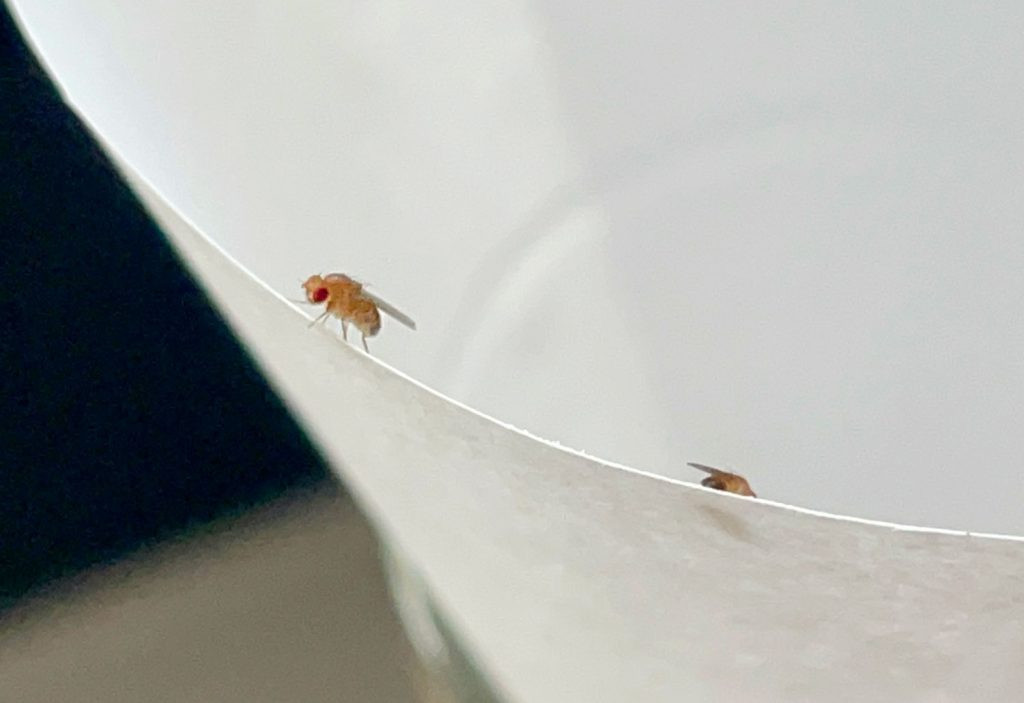 Close Up Of Fruit Fly On Paper Funnel
Close Up Of Fruit Fly On Paper Funnel
Fruit flies are small, typically tan to brownish, and have distinctive red eyes. They are about the size of a grain of rice and resemble miniature houseflies. Fungus gnats are darker, more slender, and mosquito-like in appearance. While fruit flies congregate around fruit bowls, garbage cans, and drains, fungus gnats are more commonly seen hovering around indoor plants. Drain flies, another similar pest, look like small, fuzzy moths and are usually found near sink and drain areas.
The rapid life cycle of fruit flies is why infestations can quickly escalate. A few fruit flies brought in on groceries can multiply into a swarm in days because females lay hundreds of eggs that hatch in as little as 12 hours and reach adulthood within a week. Therefore, prompt action is crucial to control their population.
To confirm if you’re dealing with fruit flies, try setting up one of the traps described below near suspected areas. If you start catching small, reddish-eyed flies, you’ve likely identified your culprit!
4 Easy DIY Fruit Fly and Gnat Traps
Getting rid of fruit flies and gnats doesn’t have to be a complicated or expensive endeavor. The principle behind effective traps is simple: lure them in and prevent their escape. We tested four different homemade trap methods, and while all showed some success, one emerged as the clear winner in our experiment. Since these traps utilize common household items, experimenting with a few is easy and cost-effective. Consider it a mini-science experiment in your kitchen!
Here are four DIY fruit fly and gnat trap methods we tested:
- Funnel Trap
- Plastic Wrap Trap
- Dish Soap Trap
- Rotting Fruit Trap
Keep in mind that some traps work faster than others, and complete eradication might take a few days, depending on the severity of the infestation.
#1: The Simple Paper Funnel Trap for Fruit Flies and Gnats
This trap design uses a paper funnel to guide fruit flies and gnats into a container baited with an attractant. The narrow opening makes it easy for them to enter but difficult to exit.
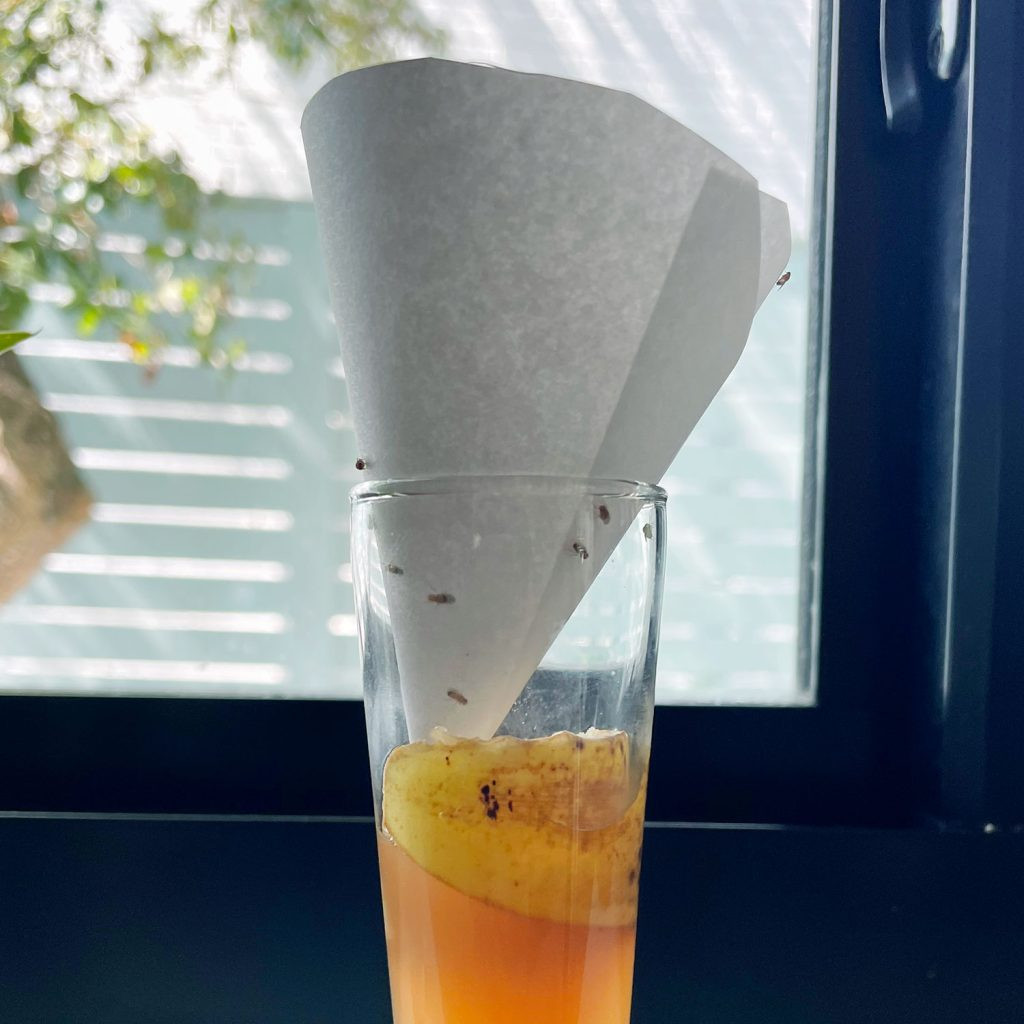 DIY Fruit Fly Trap With Paper Funnel
DIY Fruit Fly Trap With Paper Funnel
Materials:
- Small, clear jar, cup, or container with a narrow opening
- Piece of paper or cardstock
- Tape
- Scissors
- Apple cider vinegar (ACV) or ripe fruit
Instructions:
- Select a container: Choose a small, clear container like a mason jar or a repurposed food jar. A narrow opening is beneficial for this trap design.
- Add the bait: Pour a small amount of apple cider vinegar, old beer, wine, or a piece of ripe fruit into the container. These are strong attractants for fruit flies and gnats.
- Create the funnel: Roll a piece of paper into a cone shape with a very small opening at the pointed end, just large enough for a gnat or fruit fly to enter. Secure the cone shape with tape. Trim the tip to create a small opening if needed.
- Position the funnel: Place the paper funnel into the container’s opening, ensuring the wide end sits securely on the rim without touching the bait. Seal any gaps to prevent escape.
- Humane removal (optional): To release captured flies, carefully carry the trap outdoors, remove the funnel, and allow them to fly away.
While store-bought funnels can be used, their openings might be too wide, allowing easier escape. A homemade paper funnel with a narrow tip is more effective.
#2: Plastic Wrap Trap for Fruit Fly and Gnat Control
Similar to the funnel trap, the plastic wrap trap utilizes an attractant to lure fruit flies and gnats into a container, but uses plastic wrap with tiny holes to trap them.
Materials:
- Small, clear jar, cup, or container
- Rubber band
- Plastic wrap or a plastic bag
- Toothpick
- Apple cider vinegar (ACV) or ripe fruit
Instructions:
- Choose your container: A clear jar or cup is ideal for monitoring trap effectiveness, but any small container will work.
- Add the lure: Pour apple cider vinegar, old beer, wine, or place a piece of ripe fruit into the container.
- Cover with plastic wrap: Tightly stretch plastic wrap over the container opening and secure it with a rubber band. You can also use a piece of a plastic bag.
- Poke tiny holes: Use a toothpick to carefully poke a few small holes in the plastic wrap surface, just large enough for the pests to enter.
- Optional release: To release trapped flies, take the trap outside, remove the plastic wrap, and let them fly away.
Alternatively, you can use a jar lid. Puncture a small hole in a metal lid using a hammer and nail for a reusable trap top.
#3: Dish Soap Trap to Eliminate Fruit Flies and Gnats
This trap is simpler, requiring no cover. It uses dish soap to break the surface tension of the liquid bait, trapping fruit flies and gnats that land on it. Note: This method is not designed for humane removal as the soap will trap and kill the insects.
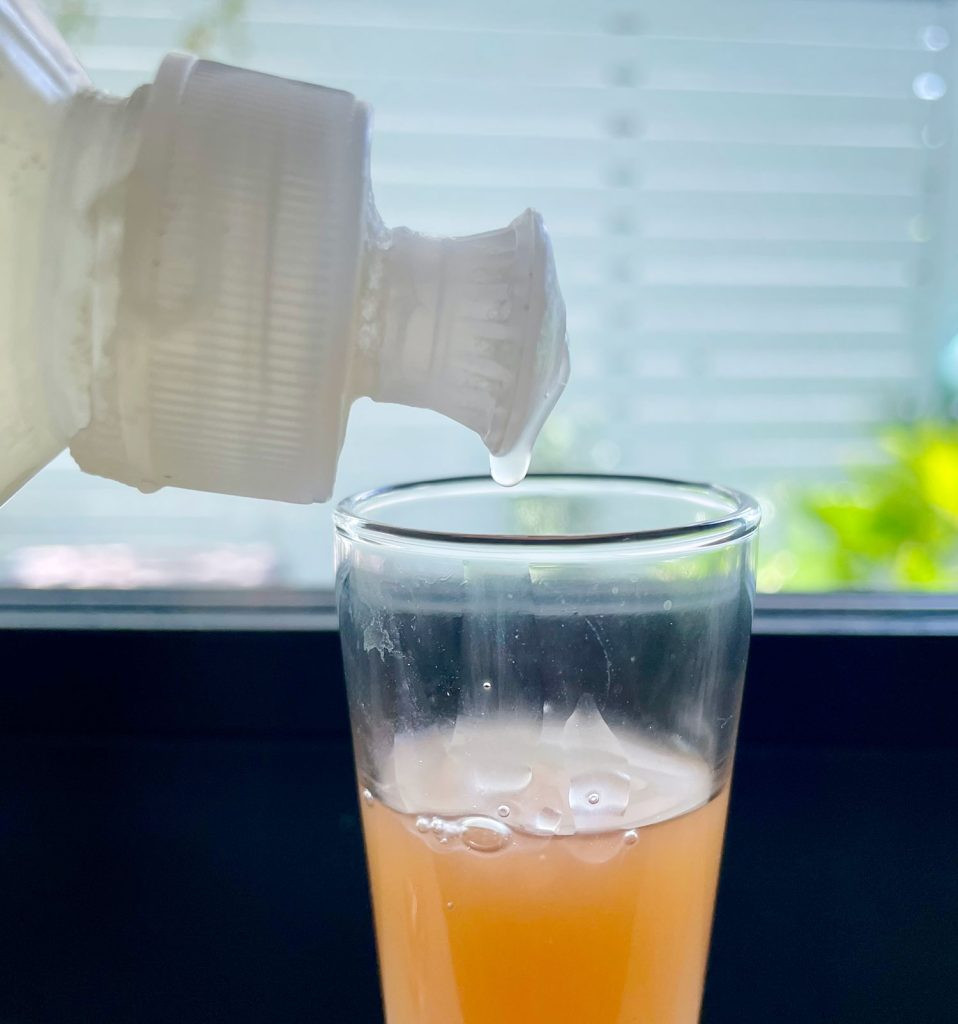 Dripping Dish Soap Into Apple Cider Vinegar For DIY Fruit Fly Trap
Dripping Dish Soap Into Apple Cider Vinegar For DIY Fruit Fly Trap
Materials:
- Small container, bowl, or dish
- Dish soap
- Apple cider vinegar (ACV) or ripe fruit juice
Instructions:
- Pour in the attractant: Fill the container with apple cider vinegar or fruit juice – anything sweet to attract the flies.
- Add dish soap: Add a few drops of dish soap to the liquid bait. Gently swirl to mix. The soap reduces surface tension, causing flies that land on the surface to sink and drown.
For enhanced effectiveness, dish soap can be added to the apple cider vinegar or fruit juice in either the plastic wrap or funnel traps. This adds another trapping mechanism.
#4: Rotting Fruit Trap for Maximum Attraction
Leveraging fruit flies’ and gnats’ strong attraction to overripe fruit, this trap substitutes or supplements vinegar with actual fruit.
Materials:
- Small jar, cup, or container
- Plastic wrap or paper funnel (depending on chosen trap style)
- Small piece of ripe fruit like banana peel, apple slice, or strawberry
Instructions:
To create a rotting fruit trap, simply replace the apple cider vinegar in the Plastic Wrap or Funnel trap with a piece of banana peel, apple slice, or other ripe fruit. You can also combine fruit with apple cider vinegar for a potent lure. Replace the fruit every day or two to maintain its attractiveness and prevent unpleasant odors.
Finding the Best Trap: Our Experiment Results
We tested a combination of these DIY traps to determine the most effective method. Our experiment included:
- Plastic Wrap Trap with banana peel
- Funnel Trap with ACV + banana peel
- Plastic Wrap Trap with ACV + dish soap
- Dish Soap Trap with ACV
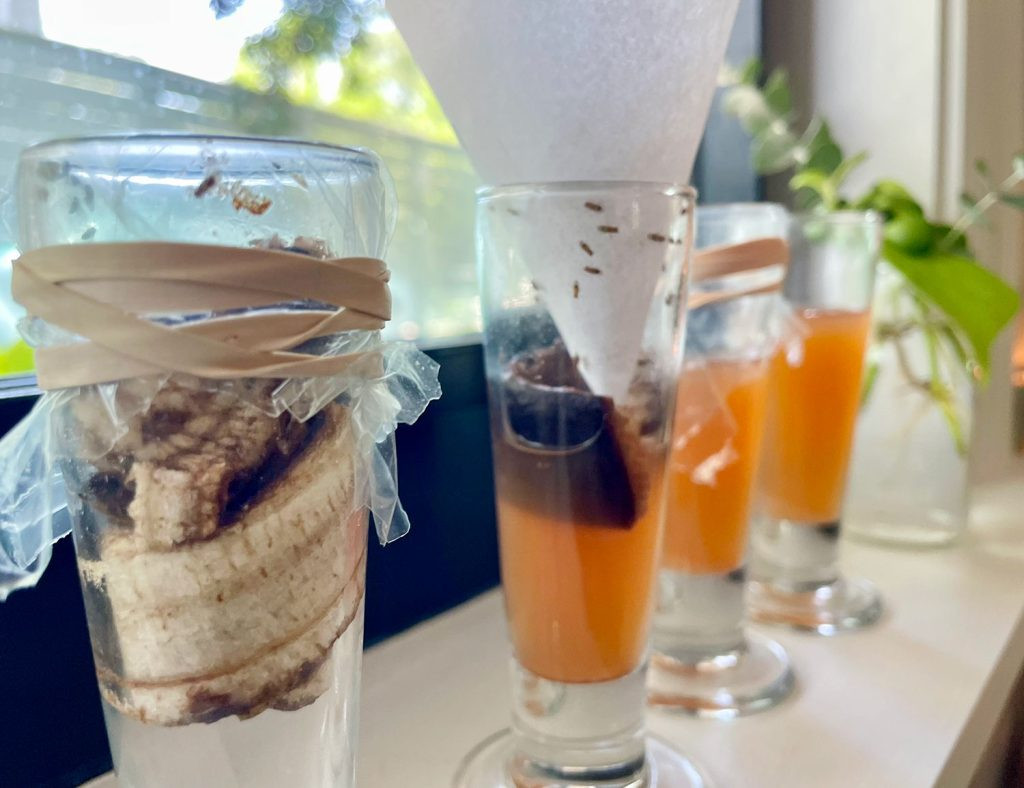 4 DIY Fruit Fly Traps Close Up
4 DIY Fruit Fly Traps Close Up
Our results indicated that the bait was more critical than the trap design. Traps using banana peel as bait significantly outperformed those using only apple cider vinegar. The Plastic Wrap Trap with banana peel and the Funnel Trap with banana peel and ACV were the most successful. It appears that while apple cider vinegar is effective, the irresistible scent of real fruit is a stronger attractant.
Based on our findings, we recommend incorporating a piece of fruit into your chosen trap for optimal results. We slightly preferred the plastic wrap trap for its ease of construction and stability – we accidentally knocked over the funnel trap once, releasing some captured flies!
What Bait Works Best to Attract Fruit Flies and Gnats?
Driven by the success of fruit scraps, we further tested which type of fruit was the most attractive bait. We compared banana peel, apple slices, and strawberry in separate Plastic Wrap Traps over 24 hours.
While banana peel initially seemed promising (being the ripest at the start), strawberry proved to be the most effective bait. The strawberry trap captured the most fruit flies and gnats, and its effectiveness increased as it became riper. Banana peel also worked well, but apple slices were not effective in attracting these pests.
Store-Bought Fruit Fly and Gnat Traps: A Convenient Alternative
If DIY traps aren’t working for you or you prefer a ready-made solution, numerous commercial fruit fly and gnat traps are available. These traps are generally affordable, discreet, and may be effective against a broader range of flying insects.
 Collage of Storebought Fruit Fly Traps
Collage of Storebought Fruit Fly Traps
We tested Terro Fruit Fly Traps against our homemade fruit and vinegar traps. In a 24-hour comparison, our homemade strawberry and banana peel traps outperformed the Terro trap. However, when left for a longer period, the Terro trap effectively captured a significant number of fruit flies and gnats.
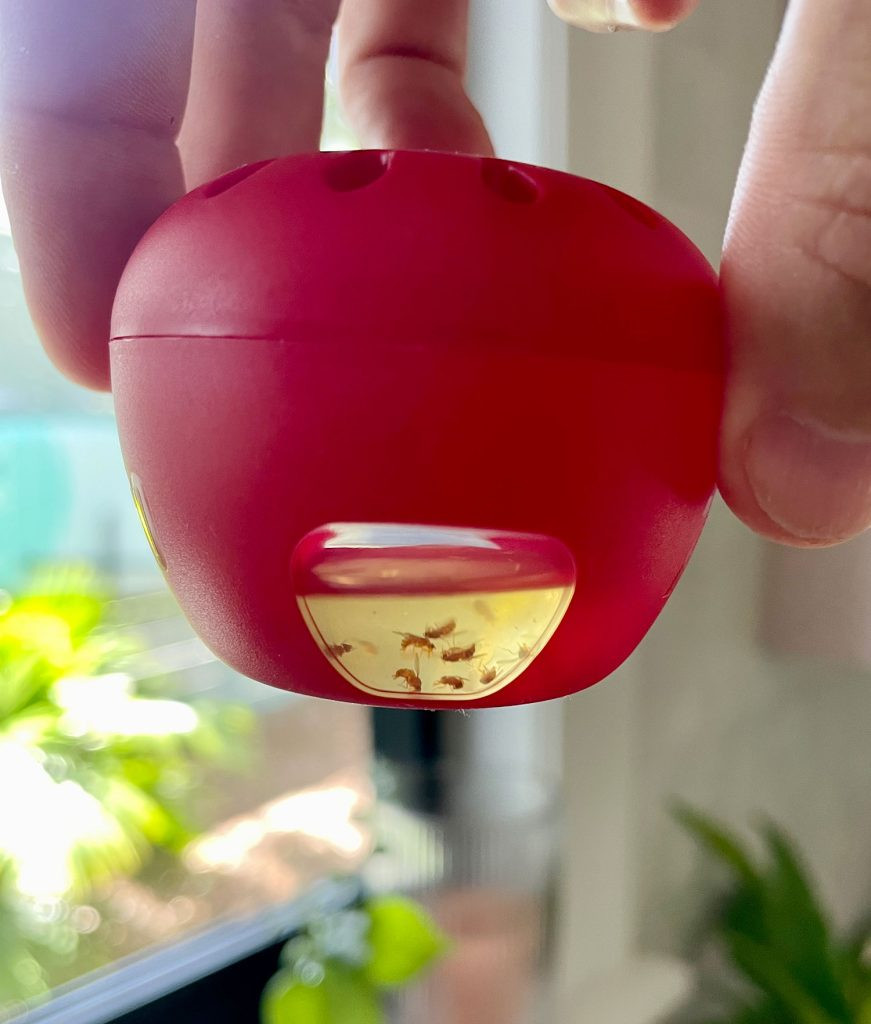 Terro Fruit Fly Trap With Dead Fruit Flies Visible
Terro Fruit Fly Trap With Dead Fruit Flies Visible
Our conclusion is that store-bought traps are a good option for a discreet, long-term solution, especially if aesthetics are a concern. However, homemade traps, particularly those baited with fruit, can be more immediately effective for quickly reducing fruit fly and gnat infestations.
Preventing Fruit Fly and Gnat Infestations: Key Steps
Prevention is always better than cure. Here are simple steps to prevent fruit flies and gnats from establishing themselves in your home:
- Maintain clean kitchen surfaces: Regularly wipe down counters, stovetops, tables, and any surfaces prone to food residue or spills, especially from fruit, sugary drinks, and alcohol.
- Empty trash regularly: Food scraps in garbage cans are breeding grounds. Take out trash daily to eliminate food sources.
- Dispose of overripe fruit promptly: Monitor fruit bowls and discard browning or rotting fruit before they attract pests.
- Wash produce immediately: Washing fruits and vegetables upon bringing them home can remove fruit fly and gnat eggs or larvae (except for berries, which can spoil faster when washed before storage).
- Refrigerate produce: Cold temperatures deter fruit flies and gnats. Store fruits and vegetables in the refrigerator whenever possible.
- Clean sink drains: Food particles in drains attract fruit flies and gnats. Use garbage disposals regularly and flush drains with hot water or drain cleaner periodically.
Don’t panic if you spot fruit flies or gnats. Quick action with these easy and effective DIY traps and preventative measures will help you regain control of your kitchen and enjoy a pest-free home. You might even find the process of experimenting with traps a little bit fun, just like we did!
*This post contains affiliate links, so we may earn a small commission when you make a purchase through links on our site at no additional cost to you.
